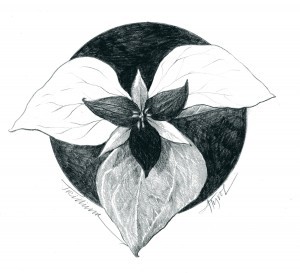
The fleeting interval between late-April and mid-May, after the snow has melted yet before the canopy of leaves overhead is fully deployed, is when many of our native woodland flowers, such as trillium and trout lily, find their brief moment in the sun. These flowers are often referred called “spring ephemerals” since, after the trees leaf out and block the sun’s rays, they set seed, die back, and disappear. Spring ephemerals such as squirrel corn and Dutchman’s breeches spend 10 months of the year hidden underground.
But these flowers are ephemeral in a second way as well - they are not easy to find even at this time of year. The reason has less to do with sunlight and more to do with sheep, wool prices, and past land use in Vermont and New Hampshire.
The landscape we live in has been populated by woodland flowers ever since the forests returned after the last glacial retreat, roughly ten thousand years ago. This was true up until the late 1700s, when homestead farms began replacing woodland forests across the region. As the forests were transformed into potash, charcoal, tanbark, lumber, and firewood, the wildflowers for the most part thrived in their newly sunny circumstances.
But when the lands were subsequently plowed or grazed by sheep and cattle, spring ephemeral plants were destroyed. The conversion of woodlots to fields accelerated with the Merino sheep craze of the early 1800s, when roughly three quarters of the twin states were cleared for grazing and agriculture. The intensely grazed lands became a landscape of grasses and pasture weeds, many of which came from Europe with the sheep.
When the Merino craze went bust in mid-century, many upland landscapes were reclaimed by pine and woody plants, but for the most part, the wild flowers did not return. Or, more accurately, they are still working on returning, a century and a half later.
The seeds of many spring ephemerals are spread by ants. To spread successfully in the forest understory, trilliums, Dutchman’s breeches, hepaticas, and toothworts create tiny elaiosomes-oily packets containing their seeds-as enticements for ants. The ants collect these oily morsels to nourish their larvae and subsequently deposit the seeds into their colony compost piles.
Since ants move at an ant-like pace, spring ephemerals are only able to re-colonize woodlands very slowly. Six-legged piggybacks, combined with the six years or so required for a spring ephemeral to develop into a mature flower, means that the plants spread at an average rate of 3 inches a year.
A trillium near my house has survived the plow, the mouths, and the bulldozer. If I can help it avoid the mower and the soccer ball, the offspring of that plant might spread seven and a half feet over the course of my thirty-year mortgage. Every time I walk by, I imagine the descendants of the three-petaled flower making the journey to my mailbox, 100 feet away; an ecological recovery process that may take 400 years if all goes well.
Although three quarters of New Hampshire and Vermont were once cleared for agriculture, that leaves a quarter that was not. These are the best places to search for spring ephemerals today. These plants are refugees in the landscape and live, like the displaced, in the lands most marginal to human intentions. Think about where the plows, the paths of cattle, the phalanxes of grazing sheep, and the bulldozers might have been in the past. Then look elsewhere.
Botanist Henry Art at Williams College found a lithograph with a bird’s eye view of Williamstown, Massachusetts, etched in 1830. The cartographer had illustrated the homesteads and mills and also the remnant woodlots. Williams College researchers subsequently re-located these old woodlots and found many of them to be outstanding reservoirs of wildflower density and diversity.
Where in your town are the patches of forest that never, or rarely, saw the plow or the sheep? These were often rocky places that were hard to access or cultivate. Some of these were areas regularly cut for fuelwood that nevertheless remained continuously in forest cover, albeit reduced. Look here for blue cohosh, wild ginger, large-flowering bellwort, and hepatica.
Some spring ephemerals can be found in unexpected places, like along the edges of old roadways in the narrow swath of land between the drainage ditch and a stone wall. The flowers have been smothered near the ditch and grazed along the far side of the wall, leaving a narrow strip that may have hosted these flowers continuously for thousands of years.
Finding spring ephemerals can mean finding a rare snapshot of the native understory from the time of our great, great, great, great, grandparents. And, if the ants have their way, of an equally distant future.

